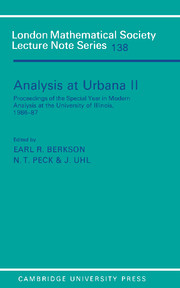Book contents
- Frontmatter
- Contents
- Acknowledgements
- PREFACE
- The C1contractions
- Factorization theorems for integrable functions
- Spectral decompositions and vector-valued transference
- Vector-valued Hardy spaces from operator theory
- Restricted invertibility of matrices and applications
- The commuting B.A.P. for Banach spaces
- The minimal normal extension of a function of a subnormal operator
- Two C*-algebra inequalities
- The generalised Bochner theorem in algebraic scattering systems
- Differential estimates and commutators in interpolation theory
- A survey of nest algebras
- Some notes on non-commutative analysis
- Some remarks on interpolation of families of quasi-Banach spaces
- An application of Edgar's ordering of Banach spaces
- Martingale proofs of a general integral representation theorem
An application of Edgar's ordering of Banach spaces
Published online by Cambridge University Press: 05 September 2013
- Frontmatter
- Contents
- Acknowledgements
- PREFACE
- The C1contractions
- Factorization theorems for integrable functions
- Spectral decompositions and vector-valued transference
- Vector-valued Hardy spaces from operator theory
- Restricted invertibility of matrices and applications
- The commuting B.A.P. for Banach spaces
- The minimal normal extension of a function of a subnormal operator
- Two C*-algebra inequalities
- The generalised Bochner theorem in algebraic scattering systems
- Differential estimates and commutators in interpolation theory
- A survey of nest algebras
- Some notes on non-commutative analysis
- Some remarks on interpolation of families of quasi-Banach spaces
- An application of Edgar's ordering of Banach spaces
- Martingale proofs of a general integral representation theorem
Summary
Abstract
We examine and extend several results about the universal Pettis integral property using a uniform approach via Edgar's ordering structure on Banach spaces. This reduces the problem from one concerning integrable functions to a purely Banach space setting.
Introduction
Originally defined in 1938 by B. J. Pettis, the Pettis integral lay dormant for forty years, elusive and seemingly banished to the realm of mathematical curiosities. Since 1978, however, substantial progress has been made, particularly for functions taking values in the dual of a Banach space. There are essentially two basic ways in which to study the integrability properties of functions. One is to concentrate on a particular function f : Ω → X and find conditions on f for which it will be Pettis integrable. This can be done, for example, in terms of an appropriate convergence of simple functions, looking at the core of the function [9], or examining the set {x*f : ∥x*∥ ≤ 1}. This approach has successfully lead to various characterizations of the Pettis integral, for which the monograph [16] by M. Talagrand provides an excellent reference. Recent results have also been attained by Riddle-Saab [12] and Andrews [1] on functions that are universally Pettis integrable, that is, functions defined on a compact Hausdorff space and Pettis integrable with respect to all Radon measures on that space.
The other approach is to study the Banach space X and find conditions on X for which all functions into X will be Pettis integrable under certain suitable measurability conditions.
- Type
- Chapter
- Information
- Analysis at Urbana , pp. 275 - 293Publisher: Cambridge University PressPrint publication year: 1989



